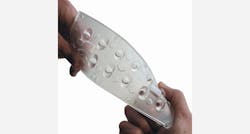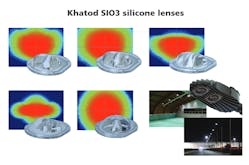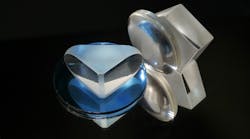At a black-tie Gala held in the Mandalay Bay Convention Center (Las Vegas, NV) on Feb. 28, 2019, LEDs Magazine announced our fifth annual Sapphire Awards winners. As always, the award winners spanned the breadth of packaged LEDs and other enabling technologies to solid-state lighting (SSL) products intended for general illumination and specialty applications, and we named our Illumineer of the Year for 2019. As part of our ongoing celebration of the winners, and the innovation inherent in their work, we recently interviewed Luca Meneghetti, technical director at Khatod, about the Nactus 6x2 SIL silicone LED secondary optic that took the Sapphire Enabling Technology award. Optics represent a critical element of luminaire design that must both be optically efficient and match requirements of an application at hand in terms of beam distribution and reliability. Read on to learn more about how an innovative optic can enhance SSL product development.
LEDs Magazine: Hi Luca, and congratulations on winning an LEDs Magazine Sapphire Award for your Khatod Nactus 6x2 SIL silicone LED secondary optics. SSL products are complex systems, as we’ve written numerous times over the years. And the product development challenge is a multidisciplinary one involving electronic, thermal, and of course optical elements. For an end product to deliver optimal performance, every element must be done right, and optics often are the elements that determine uniformity of light and visual comfort. Our Sapphire judging panel clearly valued the innovation in your Nactus product and what the secondary optic could deliver in quality of light and in secondary benefits such as protection for the LEDs.
How do you approach the development of a new optic such as Nactus? Are you driven by specific application requirements and customers? Or do the characteristics of specific new packaged LEDs prompt new designs?
Luca Meneghetti: I would say that the first impulse that moves Khatod to approach the development of a new optic, whatever it is, is the typical attitude that distinguishes Khatod in every project we undertake — innovation. Innovation culture is in our DNA and represents the breeding ground where our ideas take shape, feed on, and develop. This is exactly what happened with silicone, already some years ago. And I could say the same for many other projects, some of which, like our silicone optics, are patented.
For sure, new LEDs offer enormous potential for dozens of applications — a fact rather hard to imagine until recently. Our innovation capacity, together with LEDs, yield the perfect situation for imagining and creating new optical solutions. As an example, let’s think about the great development and implementation that LED lighting is having in horticultural and animal care applications. What’s better than lenses and optical systems made of silicone?
Of course, creativity and innovative spirit are not enough to reach great results. The involvement of our experienced optical engineers is another essential ingredient to optimize and make the most of what the inherent innovation in LEDs may offer.
LED lighting is an ever-evolving technology. It is completely natural, normal for us to match all the variations, improvements, and progress of such a tremendous technology. New and more powerful LEDs are showing up on the market, as well as the applications requiring SSL technology are constantly growing. They are more and more demanding, in terms of performance, efficiency, and specific features. Then, the new LEDs as well as the specific application requirements from the customers play a primary role in prompting new designs.
LEDs: One of the obvious characteristics of the Sapphire winning optic is the silicone material upon which it’s based and which we assume the SIL suffix in the model number infers. You were one of the first optics companies to move to offer silicone as an alternative for SSL optics a number of years ago.
What did Khatod foresee in terms of end-product benefits that drove the offering of silicone as an alternative, especially given that the material cost is higher than some of the plastic alternatives?
Meneghetti: Yes, the SIL suffix stands for silicone, just chosen to give an immediate identification with the material. We were the first mover of a full range of lenses made of silicone starting with the SIO3 silicone lenses for COB [chip-on-board] LEDs.
Nactus 6x2 SIL systems not only deploy the technology we have developed with our first series of silicone lenses but implement even further improvements both in optical and mechanical design. Designing a single lens is obviously very different from designing a multilens optical system, especially when the optical system is made of silicone. Silicone is a terrific material for its many peculiarities, but which requires great expertise as well as considerable know-how in the optical and mechanical fields.
Until Nactus 6X2 SIL, have you ever seen a system that you can twist and twist again without least affecting its perfect functionality? And what about the easiness of assembly as [our] video shows? Of course, these are rhetorical questions. We are totally sure that, until today, it does not exist, especially if you consider all its intrinsic characteristics, mechanical and optical.
As for the end-product benefits of a silicone optical system, as usual, choosing optics or optical systems made of silicone instead of any other acrylic materials mostly depends on the final application, the end product, and what the final user expects or needs to get from the optical devices they will assemble in the fixture. For instance, if the final user is looking for a highly-efficient lens that is robust and IP [ingress protection] resistant at the same time, well, this final user should have no doubts and choose a lens or an optical system made of silicone.
As for cost, perhaps the cost of silicone is higher than the cost of some plastic alternatives — but only if we take the cost of the material as a single element and disregard the final target, that is, once again, the final application. Frankly speaking, just the countless benefits of silicone — robustness, extreme temperature resistance, high flexibility, ultraviolet (UV) resistance, non-yellowing effect, etc. — are more than enough to justify the material cost. However, that must be evaluated taking into consideration the final application.
Think about Nactus 6X2 SIL. By choosing this system, the end user will be guaranteed high transparency and excellent optical efficiency. The user can rely on great robustness that eliminates any need of protective cover; [it has] great resistance to extreme temperatures as well as to cracks under harsh environmental conditions. And again but not exhaustive, the user can rely on an excellent IP protection degree that eliminates any need of gasket. Well, this end user should have no doubts about the right choice. A user with these requirements needs a lens or an optical system made of silicone.
Using Nactus 6x2 SIL, you immediately eliminate at least four costs: the cost of the gasket, the cost of the protective cover, and the costs of assembling these two elements. In addition to the elimination of some costs, if you consider how many issues it solves and how many requirements are met by a single product, I would say that Nactus 6x2 SIL is not at all expensive but certainly cost effective.
LEDs: How have silicone formulations in general evolved and advanced over the years through which Khatod has worked with the material? Specifically relative to the Nactus SIL products, what are the innovations and end-product benefits that are tied to the latest silicone formulation that you are using?
Meneghetti: The use of silicone to produce the secondary optics for LED lighting is rather recent. Until now, silicone material has not undergone substantial changes such as to make the production process different or influence the optical design. When Khatod decided to develop SIO3, the first range of silicone lenses, we have chosen the right material ever since. Our choice was based on accurate and precise tests, experiments, and so many mechanical and optical tests, having in mind the creations that we would have developed later, such as our recent Nactus 6x2 SIL.
Of course, besides the high quality of the material we use, it is equally important to fine-tune the entire production process, from the raw material to the end product. That is fundamental to achieve the result we expect and that I can say we have fully achieved.
This involves the preparation of molds and tooling enabling to meet faultlessly the specific optical geometries, edges, curvatures, etc. Any and each parameter must be evaluated with the utmost care. The molds are engineered and realized under tight tolerances and a precision I don’t hesitate to define as extreme. Also, the preparation of the whole injection equipment needs to be developed with the utmost care.
Khatod added a further refinement of the processing parameters in order to match at best both the specificity of our optical solutions and the typical characteristics of the type of silicone we chose.
The silicone material we use delivers excellent characteristics, such as great flexibility and optical pureness, just to name a few, which are completely preserved and transferred to our optics thanks to our optical and mechanical engineering. Some key benefits are:
- Excellent transparency, low absorption of light, high efficiency in light distribution
- No birefringence
- UV-resistant, non-yellowing effect
- High flexibility even at low temperature
- High resistance at extreme temperatures - -40°C to 150°C with peaks up to 200°C
- Great resistance to harsh environmental conditions
- Excellent IP protection degree
- Top level IK resistance
- No need for extra protection
LEDs: We know you offer the Nactus family of optics in a choice of silicone, polycarbonate (PC), or polymethyl methacrylate acrylic (PMMA) materials. Is it customer demand that mandates that you offer a choice of materials? Or is it more a case of the different material choices each having clear advantages relative to specific applications? Can you briefly describe the application matches for each? If cost were no factor, would the majority of SSL applications that require secondary optics move to silicone?
Meneghetti: Yes, our first Nactus models were made of PC or PMMA and this of course depends on the market demand but mostly on the final application. When we launched our Nactus module ranges, silicone technology applied to secondary optics for LED lighting was at its dawn. Our Nactus models made of PC are in great demand for street lighting as well as wide spaces, both indoor and outdoor. They offer a huge variety of solutions and perfectly comply with each market request.
Today, with the growing diffusion of SSL in applications for which silicone optics can better meet the requirements from these new contexts, the demand for silicone optical solutions is booming. The silicone versions offer some features that easily meet some new market needs, such as those from the horticultural and animal care industries where water or high humidity is constantly present. Street lighting in specific areas with peculiar, difficult climate and weather conditions often uses lenses or optical systems made of silicone. As I said before, the choice depends mainly on the user’s needs for a specific application.
Another important aspect is the top impact resistance indicated by the IK rating offered by Nactus 6x2 SIL. In general, the IK resistance is sometimes little considered, whereas it is of fundamental importance. Nactus 6x2 SIL is perfectly flexible, smooth, and does not produce splinters at all. Think of all industrial uses as well as uses under harsh environmental conditions; the high IK resistance of Nactus 6x2 SIL is one of the features that make this product excellent.
LEDs: We remember when the first silicone optics for SSL applications emerged from the development lab and one of the worries relative to the material itself was that the somewhat tacky feel of the material would equate to optics attracting dirt or grease. Does that concern exist in any way today? And does the Nactus SIL product design have any elements intended to alleviate such concerns?
Is there one benefit or characteristic related directly to the silicone material that most often leads SSL product developers to choose a silicone optic? How often are the benefits relative to sealing the LEDs from the environment a primary driver of silicone selection? Or is ingress protection mainly a secondary benefit?
Meneghetti: The silicone we use is certified as self-cleaning by the manufacturer. However, the cleaning is carried out by simply using mild soap and water and a soft cloth. Of course, the geometry construction of the lenses can emphasize or reduce the dirt attraction. This depends on the lens design as well as its use and application. As to Nactus 6x2 SIL, the lenses forming the system do not have a geometry construction that causes considerable dirt attraction. Of course, this cannot be totally eliminated due to the use case and environment.
The silicone material is not better or worse than PC or PMMA or other materials. It can be the best or not, but this depends mostly on the final application, the performance requested, and the customer’s needs. Starting from all these considerations, we are perfectly able to guide the customer towards the best choice for a specific application.
The best solution, whatever it is, is based on the final application, functionality, price, and the customer’s needs. As I said previously, the final application, and what the final user expects or needs to get from the optical devices integrated into their fixture, are fundamental elements. If the end user is looking for a lighting-efficient lens that is also robust, performs with a very good IK resistance, and is IP resistant, all at the same time with a sole product, this end user will have all advantages to choose Nactus 6x2 SIL.
LEDs: We recently attended a presentation at the facility of a lighting manufacturer with the focus at the event being outdoor lighting. This particular manufacturer is a staunch proponent of glass optics in outdoor lighting. A company executive made the statement that all alternative materials will eventually degrade or yellow, impacting optical efficiency and/or beam distribution. Could you comment on glass optics and also about the potential degradation of other materials including silicone?
Meneghetti: As I said, any material can be better or worse than any other material. It just depends on the final application and the customer’s specific requirements. Both PC and silicone are materials which can show excellent non-yellowing characteristics. Of course, yellowing mostly depends on the quality degree of the raw material you will be using.
As to the raw materials Khatod uses for the manufacturing of our optical solutions, we only use top-quality products that we buy from top producers, leaders in that business. For example, think about car headlights. They do not turn yellow; otherwise this would be a serious problem. Obviously, there are specific treatments to slow down and nearly eliminate the yellowing effect — treatments that absolutely do not interfere with the optical, mechanical, or any other characteristics of the lenses, or headlights as in this example.
There is another fundamental aspect: The optics made of glass allow limited design freedom when compared to silicone. Limitation in form would be a serious issue for the realization of optics for LED lighting. For instance, silicone allows developers to easily elaborate undercuts for specific requirements of optical performance. Also, the silicone we use for our optics was chosen for its great properties in terms of flexibility and viscosity, which contribute to offering freedom of design without optical defects for complex, high-precision parts.
As an isotropic material, silicone provides high flexibility, which allows an easy fit to the final application. And as an elastomer, this material provides a perfect compensation for the construction mechanical tolerances typical of the final application.
Glass lenses would not meet the many and ever-evolving requirements of the market, just determined by the continuous growth of applications requiring LED lighting. However, any material inevitably undergoes natural degradation over time. If we think of glass, surely it does not guarantee either the robustness of silicone or its IP properties. Glass optics would always need a gasket and would always have a certain fragility.
The silicone used by Khatod, on the other hand, guarantees a high non-yellowing degree, an excellent IP rating, a very high IK resistance, and outstanding lighting efficiency. In the end, the silicone material we use perfectly meets all major optical requirements, both because of the features I have just mentioned, and because it enables [us] to create optical solutions for every requirement.
LEDs: We assume your optical engineers spend a lot of time working with simulation software trying to match beam pattern to applications and ensuring uniformity and low glare. How do you process or manipulate silicone in your manufacturing process to change the optical properties? Is it ultimately just the shape of the silicone lens that matters?
Meneghetti: Simulation software and injection tests are fundamental, regardless of the material used.
In the case of silicone, the injection process is mostly important. Typically, silicone is injected cold while the crosslinking process occurs in the mold at 180°C temperature. Also, the silicone’s ability to form complex optical elements using multiple shots in a single injection mold, the typical characteristics of LSR 7000 liquid silicone rubber we use, and the specificity of our silicone optical solutions required an even further refinement of the processing parameters.
I say this, just to explain that, once the right beam and all the other lighting parameters have been met through simulations, they are not sufficient to ensure that the optics will perform exactly that way. You cannot change the properties of the optic; however, to achieve the result you desire, you must be able to make the most of the intrinsic properties of the silicone and transfer them unchanged, from the material to the optic you will realize, without ever losing sight of the final application for which the optic is intended.
LEDs: When we had the chance to visit your new manufacturing facility a few years back, you were still in the process of finalizing the move. But we came away very impressed with the manufacturing lines and also with the test procedures you had in place for quality. Can you tell us about the tests you perform on silicone optics and the significance of those tests for SSL product developers?
Meneghetti: Tests are fundamental for verifying the work has been carried out efficiently. We check all the processing phases in order to be certain that any issue has been addressed, resolved, and applied correctly. Since your visit a few years ago, the production department has been further strengthened by the implementation of new production units. To date, we have 52 fully automated production units and 8 semi-automated. The presence of the operator is required only for the necessary control and supervision operations.
We have significantly upgraded the dark room and implemented the IK and IP test equipment. Also the mechanical department dedicated to the construction of molds and the tooling has been considerably strengthened. Every product that comes out from Khatod is controlled and supervised to ensure the highest standards of working, performance, and quality.
Another pillar of Khatod is R&D. In our R&D department, new materials and new technologies are constantly subject to experimentation, such as micro and nanotechnologies applied to optics and to plastics of a new generation; new optical solutions based on complex surfaces, both in transmission and in reflection, are tested; new materials are tested, such as films with particular properties able to provide excellent optical performance and ensure high protection against moisture, thermal stress, and impacts — and much more.
Being innovative is not only a part of our approach. It’s just our way of being and acting. With our creative thinking and impulse to innovation, problems can be solved differently and strategically. Khatod is able to offer our customers not only a good product, but also new spaces to support them with designing and researching by offering the opportunity to take advantage of Khatod know-how and longstanding practical experience, instrumentation and equipment, laboratories, and specialized engineering. That is a comprehensive service, more and more technological and cutting-edge. We strive to be a true partner for the realization of our customers’ projects.
LEDs: We certainly know that Khatod has a reputation as a quality supplier of optical components, so it’s not a surprise to have had the Nactus SIL product named a winner. Indeed, your company has received prior Sapphire recognition. Still, we wonder what prompted the Nactus SIL entry over other Khatod products? And what has the win meant for the team in Milan and around the globe?
Meneghetti: Focusing on Nactus 6x2 SIL was a natural consequence of the development of a series of previous products, such as the Nactus range made of PC and then SIO3 silicone lenses. The SIO3 optics garnered Khatod its first Sapphire Award in 2015. Making an encore with Nactus 6X2 SIL in 2019 was really a great honor for all of us. And I allow myself a touch of pride. I think we really deserved it!
Editor’s note: Extended online version of this article - Original interview published in abbreviated form in the July/August 2019 issue of LEDs Magazine.







